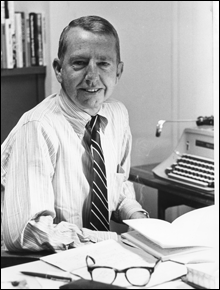
THE BEST DAILY REVIEWER/CRITIC OF ALL?: Vincent Canby at his desk. |
We can’t compete with buccaneers of the Caribbean — the sword is mightier than the pen — but film reviewers lately have been getting a smidgen of respect, thanks to the keen attention paid American Movie Critics: An Anthology from the Silents Until Now (Library of America, $40). There have been lengthy, exceedingly respectful reviews in places that count; and Phillip Lopate, the anthology’s editor, was offered, for a spring book tour, the full-plate speaking schedule of a literary star capped by multiple NPR visits. Lopate, a respected novelist and revered essayist, was part of the media draw, but the subject of “film criticism” also struck a bell. I heard two of the NPR broadcasts, and the intense call-ins from across the USA indicated that some moviegoers, at least, want to sink more deeply and thoughtfully into film criticism than catapulting through the Friday reviews.What does Lopate promise those who purchase the book? Seven hundred hand-selected pages of reviews and essays, from critics movie fans already know about (Roger Ebert, Pauline Kael) to earlier, less-read masters (William Troy, Otis Ferguson) to talented scribes even contemporary critics have never read (the pre-feminist Cecilia Ager; the African-American nay-sayer on Gone with the Wind, Melvin B. Tolson). From poet Vachel Lindsay’s prescient 1915 take on Action Pictures (“People are but types, swiftly moved chessmen”) to, today, Manohla Dargis’s droll, with-apologies-to-Theodor-Geisel rhymed attack on The Cat in the Hat (“So all we could do was Sit!/Sit!/Sit!/Sit!/And we did not like it/Not one little bit”), American Movie Critics is packed with snazzy writing. Each piece had to meet Lopate’s criterion for worthy film criticism: “It is a literary performance, in the final analysis: What is involved is the operation of one art form (literature) on another (the movies).”
He makes no distinction between reviewing — typing away in the heat of having just exited a movie — and something loftier, less time-bound, more contemplative: “criticism.” Many of his favorites are reviews done on the run, on deadline, including a half-dozen items from the late Vincent Canby. Twenty-four years behind the desk at the New York Times (1969–1993), Canby is regarded by Lopate as the best daily reviewer/critic of them all. His short list of the greatest critics? Otis Ferguson, James Agee, Manny Farber, Andrew Sarris, Pauline Kael.

It’s a noble effort, to turn readers on to the glories of film-critic artistry and wordsmanship. Most critics endorse Lopate’s postulate that the opinions offered of a movie’s worth, the consumer-oriented paragraphs, are the least interesting or significant part of our reviews. They’re the departure point for opening up the film, putting it in its generic, historical, formal, philosophical, and autobiographical contexts. Is that what readers thirst for, elegantly crafted and argued essays? I wish, but the average-joe skimmer of film reviews cares little about the æsthetic experience. He wants to know who’s in the movie, what’s the story about, and should he pony up his hard-earned bucks to see it? How many stars, and how many thumbs up? Can Lopate’s anthology make a dent?
My one kvetch about the book is minor. Lopate is too New York–centric in his choices. Chicago gets Carl Sandburg and Roger Ebert, LA just two pieces from the LA Times. And Boston strikes out. What of 30 years here at the Phoenix, from Janet Maslin and David Denby to Peter Keough? In fact, for Volume 2, why not this sterling, desirous essay from Mr. Film Culture?